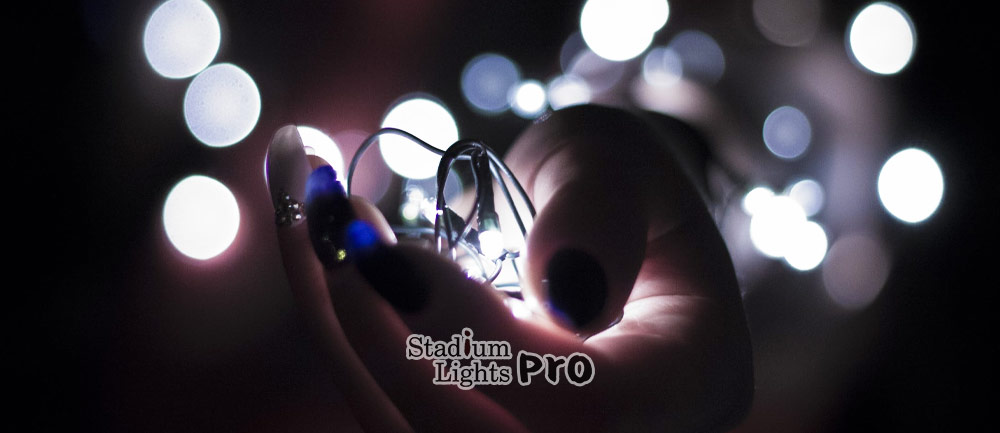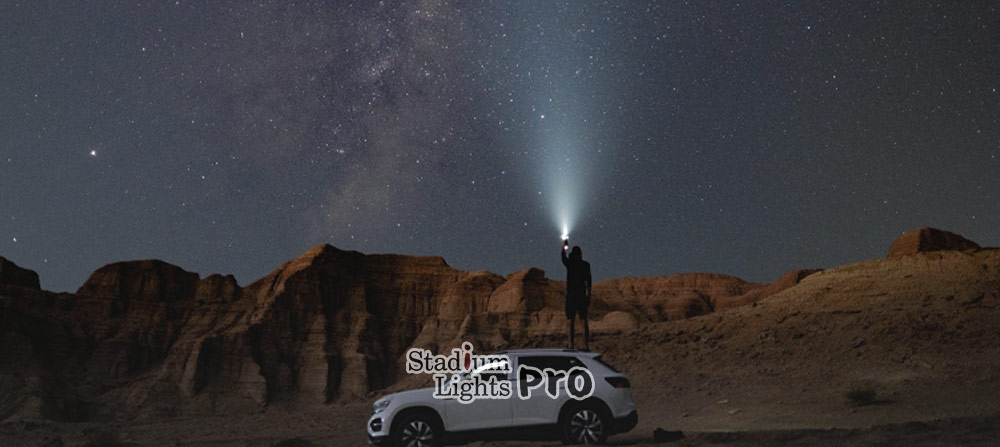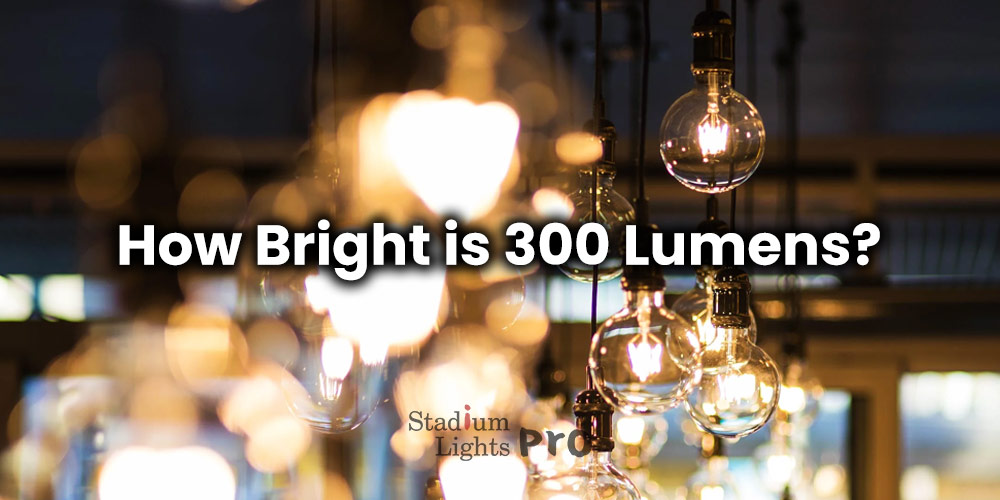A 300-lumen light source is one that produces 300 units of visible light. This is a moderate level of brightness and it can be used for a variety of tasks and settings. For example, a 300-lumen flashlight is bright enough to be used for tasks like camping, hiking, or working on a car engine, but not as bright as a searchlight.
A 300-lumen LED bulb is typically equivalent to a 25-watt incandescent bulb, which is a common brightness level for a reading or task light in a home office. It is also less bright than a 100-watt incandescent bulb, which is commonly used in living rooms and bedrooms.
Table of Contents
ToggleWhat is lumen?
Lumens is a unit of measurement used to express the amount of light produced by a source. It is used to indicate the total amount of visible light emitted by a lamp or light fixture. The purpose of measuring light in lumens is to provide a standard way to compare the brightness of different light sources. This makes it easier for consumers to understand how much light a particular lamp or fixture will produce, and to compare the brightness of different options. It also helps manufacturers to produce and label their products with the accurate information about light output, which helps customers make informed decisions when purchasing lights.
Comparison of 300 lumens to other light sources

300 lumens is equivalent to a 25-watt incandescent bulb
300-lumen light source produces roughly the same amount of visible light as a 25-watt incandescent bulb. This is a rough comparison as it is not an exact equivalency, as different types of light sources can produce different color temperatures and spectrum of light.
The efficiency of a light source, also known as luminous efficacy, can vary greatly between different types of light sources, for example, LED lights are more efficient in converting energy into light than incandescent bulbs. However, as a rough comparison, it is a useful way to understand the relative brightness of different light sources.
300 lumens is less bright than a 100-watt incandescent bulb
A 100-watt incandescent bulb produces about 1600-1700 lumens, which is significantly more than 300 lumens. A 100-watt incandescent bulb is commonly used in living rooms, bedrooms, and other high-traffic areas of a home, while a 300-lumen light source is generally considered a moderate level of brightness and is more suitable for tasks such as reading or working on a computer. It is also less bright than a 100-watt incandescent bulb, which makes it more suitable for certain areas where a lower level of light is needed.
How 300 lumens is used in everyday life?

300 lumens is the typical brightness of a flashlight
It is common for a flashlight to have a brightness level of around 300 lumens. This level of brightness is considered to be suitable for a wide variety of tasks, such as camping. It is bright enough to provide a decent amount of light to see by, but not so bright that it will be overwhelming or blinding in close quarters. However, some flashlights can be brighter or less bright than 300 lumens. It depends on the specific model and brand of the flashlight, as well as the intended use.
The measurement of the brightness of a flashlight is not always accurate, as some manufacturers may exaggerate the brightness in their product specifications. Therefore, we may consult with independent reviews and tests to get a more accurate picture of the flashlight’s brightness level.
300 lumens is the minimum recommended brightness for a task light in a home office
300 lumens is generally considered to be a minimum recommended level of brightness for a task light in a home office. This level of brightness is sufficient for activities such as reading, writing, or working on a computer. It provides enough light to see by without causing eye strain or fatigue. Yet, the appropriate level of brightness can vary depending on the specific task and the individual’s preference. Some people may prefer a brighter level of light for their task, while others may find 300 lumens to be too bright.
The recommended brightness for a task light may also vary depending on the size of the room and the ambient lighting. A task light in a home office with a lot of natural light or good ambient lighting might be less bright than in a darker room. Besides, the color temperature of the light can also affect the perception of brightness, for example, a cool white light (5000K – 6000K) will feel brighter than a warm white light (3000K – 4000K) even though they have the same lumen output.
Suggested reading: 4000K vs 6000K lighting
Is 300 lumens bright enough?
For indoor use, 300 lumens is typically enough to provide adequate lighting for tasks such as reading, writing, and working at a desk. However, if you are trying to light up a large room or outdoor space, 300 lumens may not be sufficient. In outdoor settings, you may need more lumens to ensure proper visibility and safety.
The ambient light of the environment also plays a role in how bright 300 lumens will appear. In a dark room 300 lumens will appear brighter than in a well-lit room.
Is 300 lumens bright enough for headlamp?
300 lumens is generally considered to be a moderate level of brightness for a headlamp, but it may not be bright enough for certain activities that require a higher level of visibility such as caving, technical climbing or search and rescue operations.
A headlamp with 300 lumens will provide enough light for close-up tasks such as reading maps or setting up a tent. It can also be used to navigate on well-trodden paths or to see obstacles or hazards on the trail. However, it may not be bright enough to light up a large area or to see distant objects clearly.
It has a beam distance between 50-90 meters, which is good for most activities like hiking, camping, running, and even work tasks. However, if you need a headlamp for more demanding tasks, you may want to look for headlamps with a higher lumen output.
Is 300 lumens bright enough for bike?
A bike light with 300 lumens provides enough light to see and be seen by others on the road. It can also be used to navigate on well-lit streets or bike paths, and to see obstacles or hazards on the road. However, it may not be bright enough to light up a large area or to see distant objects clearly.
A 300-lumen bike light will have a beam distance between 30-50 meters, which is good for most urban and suburban riding. However, if you need a bike light for more demanding tasks, such as off-road riding or for riding in rural areas, you may want to look for bike lights with a higher lumen output.
It also depends on the individual’s preference, some people may find 300 lumens too bright for close-up tasks and others may find it too dim for long-distance visibility.
Is 300 lumens bright enough for projector?
A projector with 300 lumens can provide enough light to create a clear and visible image in a small to medium-sized room with low ambient light. However, it may struggle to produce a clear and visible image in a large room or in a room with high ambient light. The image will appear dimmer and less vibrant, and the visibility may be affected by the surrounding light.
It will have a maximum screen size of around 80 inches and a maximum distance of around 10 feet. However, if you need a projector for larger rooms or for use in rooms with high ambient light, you may want to look for projectors with a higher lumen output, ideally 2000 lumens or more.
Remember that the projector’s resolution, contrast ratio and other features also play a crucial role in the overall performance and image quality.
How many lumens is enough?
The amount of lumens considered to be “bright” can vary depending on the context and the intended use of the light. In general, a light with a high lumen output is considered to be bright.
For instance, a flashlight with 50-100 lumens is bright enough for most everyday tasks such as reading a map or finding your way around a dark room.
A headlamp with 300-500 lumens is bright enough for most outdoor activities.
A flashlight with 500-1000 lumens is considered to be very bright and can be used for activities such as search and rescue or caving, or for illuminating large areas.
For car headlights, typically, a low beam of around 600 lumens and high beam of around 1200 lumens are considered bright enough for most driving conditions.
How far can 300 lumens flashlight reach?
The distance that 300 lumens can reach will depend on several factors, including the type of light source, the beam angle, and the reflectivity of the surfaces in the environment.
A flashlight with a focused beam and a reflector will reach farther than a lightbulb with a wide beam angle. Additionally, the reflectivity of the surfaces in the environment will also play a role in how far the light can reach. In general, a light will travel farther in a dark environment than in a brightly lit environment.
In general, a flashlight with a focused beam and a reflector with 300 lumens would reach around 100 – 200 meters in dark environment. However, this is a rough estimate and actual distance can vary depending on the specific light source and the conditions of the environment.
How many watts is 300 lumens LED bulb?
To calculate the watt equivalent of 300 lumens, you can use the following formula –
Watts = Lumens / Lumens per Watt
The efficiency of a light bulb is measured in lumens per watt (lm/W). Different types of light bulbs have different efficiencies. For example, a traditional incandescent bulb has an efficiency of around 15 lm/W, while a LED bulb can have an efficiency of 100 lm/W or more.
So, to calculate the watt equivalent of 300 lumens using the above formula:
Watts = 300 lumens / 100 lm/W (LED efficiency)
Watts = 3 watts
It means that a LED light bulb with an efficiency of 100 lm/W will produce 300 lumens using only 3 watts of power.
How to convert 300 lumens to lux?
To convert lumens to lux, you can use the following formula –
Lux = Lumens / Area
Where area is the size of the area being illuminated, measured in square meters.
For example, if you have a light source emitting 300 lumens and you want to know the lux level on a 1 square meter surface, you can calculate it as follows:
Lux = 300 lumens / 1 square meter
Lux = 300 lux
It means that a light source emitting 300 lumens will produce 300 lux on a surface of 1 square meter.
This calculation is based on the assumption that the light is spread evenly over the 1 square meter surface and that no light is lost due to reflection or absorption. In reality, the lux level will also depend on the reflectivity of the surfaces in the room, the distance between the light source and the surface and the angle of the light.
Also, Lux is the measure of the amount of light that falls on a surface, and it’s not the measure of the amount of light emitted by a source.
How to convert 300 lumens to candela?
Candela (cd) is the unit of measurement for the luminous intensity of a light source in a specific direction. It’s a measure of how bright the light is in a particular direction. To convert lumens to cand, you will need to know the angle of the light source and the distance between the light source and the surface you want to measure.
The formula to convert lumens to cand is –
Candela = Lumens / (4 * π * Distance^2)
Where distance is measured in meters and π is approximately 3.14
For instance, if you have a light source emitting 300 lumens and you want to know the cand level on a surface that is 2 meters away from the light source, you can calculate it as follows –
Candela = 300 lumens / (4 * 3.14 * 2^2)
Candela = 37.7 cand
It means that a light source emitting 300 lumens will produce 37.7 cand on a surface that is 2 meters away from the light source.
Conclusion
300 lumens is considered a moderate level of brightness that is suitable for a range of applications, but not as bright as some other options.
If you have any questions or doubts about how to achieve a 300-lumen lighting setup, or are wondering whether 300 lumens is the appropriate level of brightness for your venue, please don’t hesitate to reach out to us. We would be more than happy to provide you with any additional information or guidance that you may need.

